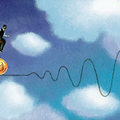 Illustration: Pietari Posti
Illustration: Pietari Posti93 beats per minute.
It's 5:45 am and I just cut myself shaving. I never cut myself shaving. Lather, bits of stubble, and flecks of blood drip onto a heart-rate monitor strapped across my chest. I'm going skydiving today, hence my case of frayed nerves — and the monitor. Heart rate will be a way to quantify how scared jumping out of a plane makes me. My best estimate: shitless. I figure that's somewhere around 150 bpm. But I shouldn't be very nervous at all. Skydiving isn't the death-defying sport it once was. Thanks to high tech gear, from idiotproof chutes to specialized planes, leaping from an aircraft now involves about as much skill — and as much risk — as riding a roller coaster.
65 beats per minute.
On the way to SkyDance SkyDiving in Davis, California, I hit 90 on my motorcycle. Yes, I'm aware of the irony, but riding a bike doesn't scare me like flying does. I try to relax, knowing professional daredevils will prep me for my assisted free fall. It's a solo dive, but instructors will flank me all the way down.
102 beats per minute.
In the hangar, Neal, an 18-year-veteran instructor, shows me the gear that will keep me out of a closed casket. First up are the main and reserve chutes. Both are oversize at 275 square feet and shaped like wings to descend gently. The chances of both failing: roughly one in 60 million.
Two altimeters will let me know when to open a chute. One gets strapped to my arm; the other goes into my helmet and will beep loudly when it's time to pull the cord. Finally, I'm fitted with an automatic activation device. It's a small explosive that, should I go limp with terror, blasts a chute open at 750 feet.
127 beats per minute.
I'm strapped into a PAC 750XL, the only civilian aircraft designed specifically for skydiving. It's a safety feature in itself. Fat wings provide enough air resistance for it to land at speeds as low as 40 mph. And I'm told the single-point seat belts, which hook into your skydiving rig to distribute the impact over your whole body, greatly increase the chances of surviving a (gulp) rough landing.
The engines roar to life and we take off. At 13,500 feet the pros on board exit one by one. Neal looks at me. I shake my head. No way. As the plane descends for landing, I catch a glimpse of my heart rate: 148 bpm.
Heart-rate monitor off.
I'm not sure if it's the sting of wind or ego that causes my eyes to tear as I ride home. I don't know why I feel perfectly fine shoulder-to-wheel with trucks on the highway, but jumping out of an airplane with the latest gear is a nonstarter.
I twist the accelerator to make a stop light, but when I try to ease off, the throttle sticks. I panic, hit the brakes, and the bike flips. A sound like a gunshot rings inside my helmet as I slam into the ground. As the aperture of consciousness constricts, the answer hits me harder than the asphalt: Every technology has its limits — and I'm not willing to test them at 13,500 feet.





